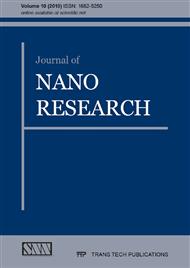[1]
D. Hull, D.J. Bacon, Introduction to Dislocations (Butter-Heinemann, Oxford, 2001).
Google Scholar
[2]
X.Z. Liao, F. Zhou, E.J. Lavernia, S.G. Srinivasan, M.I. Baskes, E.W. He, Y.T. Zhu, Appl. Phys. Lett. 83 (2003) 632-634.
DOI: 10.1063/1.1594836
Google Scholar
[3]
M.A. Haque, M.T.A. Saif, Proc. Natnl. Acad. Sci. 101 (2004) 6335-6340.
Google Scholar
[4]
J. Narayan, J. Appl. Phys. 100 (2006) 34309-1-5.
Google Scholar
[5]
J.P. Hirth, J. Lothe, Theory of Dislocations (McGraw-Hill, New York, 1968).
Google Scholar
[6]
W. Bollmann, Crystal Defects and Crystalline Interfaces (Springer-Verlag, Berlin, 1970).
Google Scholar
[7]
J.P. Hirth, Acta Mater. 48 (2000) 93-104.
Google Scholar
[8]
J. Narayan, J. Appl. Phys. 100 (2006) 034309.
Google Scholar
[9]
L. Sun, A.V. Krasheninnikov, T. Ahlgren, K. Nordlund, F. Banhart Phys. Rev. Lett. 101 (2008) 156101.
Google Scholar
[10]
U. Stigh, Mech. Mater. 14 (1993) 179-187.
Google Scholar
[11]
K. Sasaki, M. Kishida, Y. Ekida, Intl. J. Num. Meth. Engg. 54 (2002) 671-683.
Google Scholar
[12]
K.W. Schwrz, J. Appl. Phys. 85 (1999) 108-119.
Google Scholar
[13]
D. Raabe, Z. Metallkd. 87 (1996) 493-497.
Google Scholar
[14]
R.G. Hoaglang, J.P. Hirth, P.C. Gehlen, Philos. Mag. 34 (1976) 413-439.
Google Scholar
[15]
S. Tamaki, N. Ide, I. Okada, K. Kojima, Jpn. J. Appl. Phys. 37 (1998) 6115-6116.
Google Scholar
[16]
J.A. Moriarty, V. Vitek, V.V. Bulatov, S. Yip, J. Comput-Aided Mater. 9 (2002) 99-132.
Google Scholar
[17]
C.H. Henager, R.G. Hoagland, Scripta Mater. 50 (2004) 1091-1095.
Google Scholar
[18]
X. Liu, S.I. Golubov, C.H. Woo, H. Huang, Mater. Sci. Engg. A 365 (2004) 96-100.
Google Scholar
[19]
C. Woodward, S.I. Rao, Philos. Mag. A 81 (2001) 1305-1316.
Google Scholar
[20]
J.A. Moriarty, J.F. Belak, R.E. Rudd, P. Söderlind, F.H. Streitz, L.H. Yang, J. Phys.: Condens. Mater. 14 (2002) 2825-2857.
DOI: 10.1088/0953-8984/14/11/305
Google Scholar
[21]
C. Zener, Trans. Am. Inst. Min. Engrs. 147 (1942) 361-368.
Google Scholar
[22]
A. Seeger, P. Haasen, Philos. Mag. 3 (1958) 470-475.
Google Scholar
[23]
R.E. Peierls, Proc. Phys. Soc. 52 (1940) 34-37.
Google Scholar
[24]
F.R.N. Nabarro, Proc. Phys. Soc. 59 (1947) 256-259.
Google Scholar
[25]
J.N. Wang, Mater. Sci. Eng. A 206 (1996) 259-269.
Google Scholar
[26]
B. Joós, M.S. Duesbery, Phys. Rev. Lett. 78 (1997) 266-269.
Google Scholar
[27]
J. Hartford, B. Sydow, G. Wahnström, B.I. Lundqvist, Phys. Rev. B 58 (1998) 2487-2496.
Google Scholar
[28]
R.C. Picu, J. Mech. Phys. Solids 50 (2002) 717-735.
Google Scholar
[29]
V.A. Lubarda, X. Markenscoff, Arch Appl. Mech. 77 (2007) 147-154.
Google Scholar
[30]
G. Schoeck, Phys. Rev. Lett. 82 (1999) 2310-2313.
Google Scholar
[31]
J.J. Gilman, Philos. Mag. 87 (2007) 5601-5606.
Google Scholar
[32]
F.R.N. Nabarro, Philos. Mag. A 75 (1997) 703-711.
Google Scholar
[33]
P. Khanikar, A. Kumar, A. Subramaniam, Adv. Mater. Res. 67 (2009) 33-38.
Google Scholar
[34]
A. Dutta, M. Bhattacharya, P. Barat, P. Mukherjee, N. Gayathri, G.C. Das, Phys. Rev. Lett. 101 (2008) 115506-1-4.
Google Scholar
[35]
C.L. Lee, S. Li, Math. Mech. Solids, 13 (2008) 316-335.
Google Scholar
[36]
E.A. Brandes (Ed), Smithells Metals Reference Book, Butterworths, London, (1983).
Google Scholar
[37]
T. Benabbas, P. Francois, Y. Androussi and A. Lefebvre, J. Appl. Phys. 80 (1996) 2763-2767.
Google Scholar
[38]
Y.W. Zhang, A.F. Bower, J. Mech. Phys. Solids 47 (1999) 2273-2297.
Google Scholar
[39]
A. Rosenauer, D. Gerthsen, D. Van Dyck, M. Arzberger, G. Bohm, G. Abstreiter, Phys. Rev. B 64 (2001) 245334-1-15.
Google Scholar
[40]
P. Schall, I. Cohen, D.A. Weitz, F. Spaepen, Science 305 (2004) 1944-(1948).
Google Scholar
[41]
G. Schoeck, W. Püschl, Mater. Sci. Engg. A 189 (1994) 61-67.
Google Scholar
[42]
A. Aslanides, V. Pontikis, Philos. Mag. Lett. 78 (1998) 377-383.
Google Scholar


